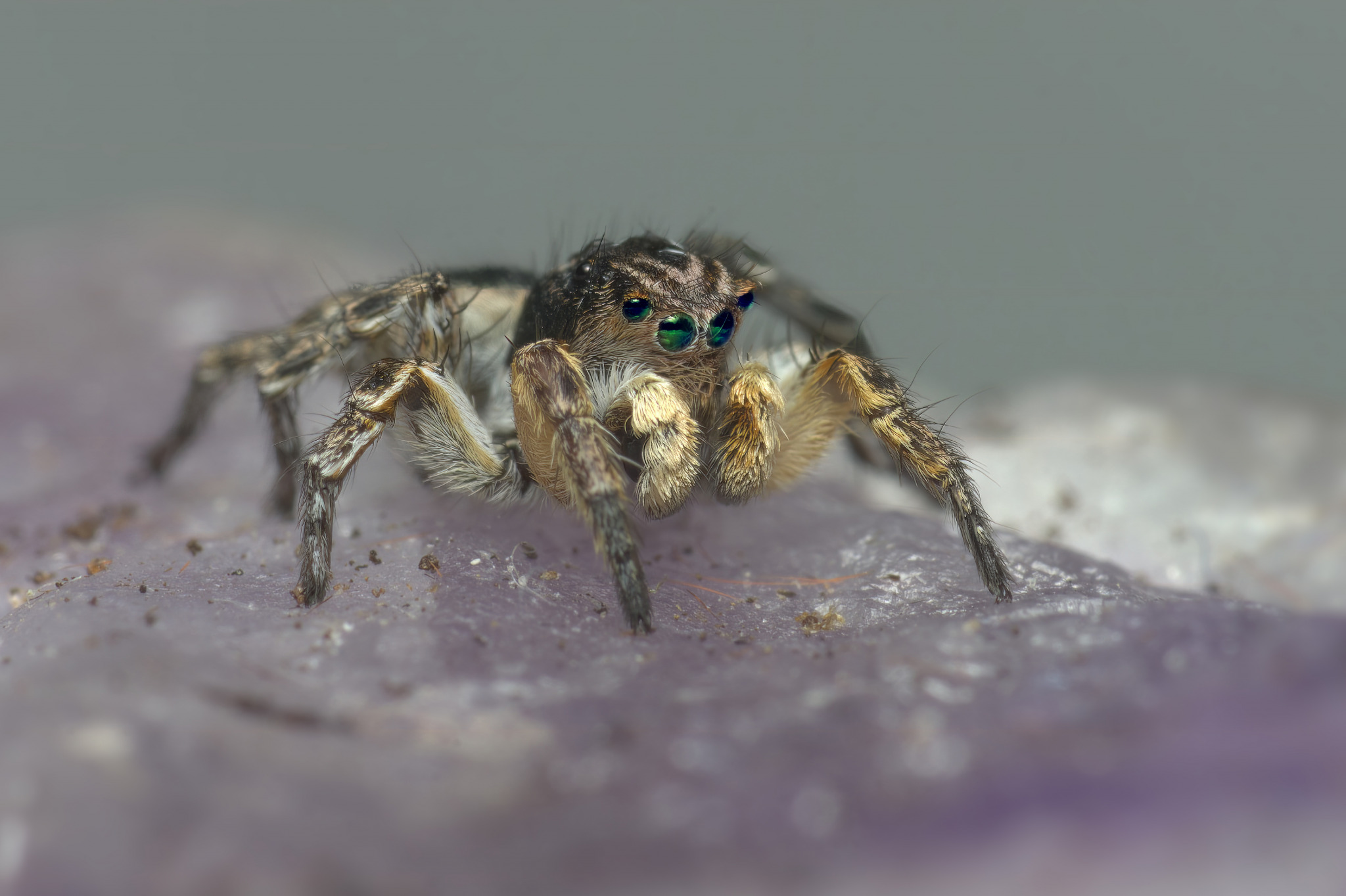Aelurillus v-insignitus is a species of jumping spider belonging to the family Salticidae. This species is known for its characteristic jumping ability, keen vision, and distinctive markings. Here’s an overview of the Aelurillus v-insignitus:
Appearance
- Size:
- Females: Typically larger, ranging from 6 to 9 millimeters in length.
- Males: Slightly smaller, around 5 to 7 millimeters in length.
- Coloration:
- Body: Generally covered in dense, velvety hair. Males often have striking markings and a more vibrant appearance compared to females.
- Pattern: Both sexes have a characteristic “V” shape on the back of the cephalothorax, which gives the species its name.
Habitat
- Preferred Habitats: Found in a variety of environments, including grasslands, scrublands, and occasionally in human habitats like gardens and parks.
- Geographic Range: Widely distributed across Europe and parts of Asia.
Behavior
- Web:
- Unlike many other spiders, jumping spiders do not rely on webs to catch prey. They use their silk primarily for creating draglines and protective retreats.
- Feeding:
- Diet: Predominantly insects and other small arthropods.
- Hunting: Actively hunts prey using excellent vision and powerful jumping ability. They stalk their prey and pounce from a distance.
Life Cycle
- Eggs:
- Females lay eggs in silk sacs, which are often hidden in crevices or under stones.
- Spiderlings:
- After hatching, spiderlings stay near the egg sac for a short period before dispersing.
- Adults:
- Jumping spiders undergo several molts before reaching maturity. Adults are typically seen during warmer months.
Identification Tips
- Distinct Markings: Look for the “V” shaped marking on the cephalothorax.
- Jumping Behavior: Their characteristic jumping movements are a key identifier.
Ecological Role
- Pest Control: As predators of insects, they play a crucial role in controlling pest populations.
- Food Web: Serve as prey for birds, reptiles, and larger spiders.
Conservation Status
- Population: Generally stable with no significant threats.
- Threats: Habitat destruction and pesticide use can impact local populations.
Conservation Efforts
- Habitat Preservation: Maintaining natural areas and reducing pesticide use helps support their populations.
- Gardening Practices: Encouraging biodiversity and avoiding chemical treatments in gardens can provide suitable habitats for these spiders.
Human Interaction
- Beneficial: These spiders are beneficial in gardens due to their role in controlling insect populations.
- Bites: Generally not harmful to humans. Bites are rare and occur only if the spider feels threatened.
Summary
Aelurillus v-insignitus is a fascinating species of jumping spider known for its distinctive “V” shaped marking and impressive jumping abilities. Widely distributed and beneficial for controlling insect populations, these spiders are an important part of the ecosystem. Recognizable by their unique markings and active hunting behavior, Aelurillus v-insignitus is an interesting and valuable species in the natural world.
Jumping spiders are a diverse group of spiders belonging to the family Salticidae, known for their excellent vision, agility, and unique hunting behavior. Here’s some information about jumping spiders:
- Appearance: Jumping spiders are generally small to medium-sized spiders, with most species ranging from 3 to 10 millimeters in length. They have compact bodies, short legs, and large, forward-facing eyes. Their eyesight is exceptional for spiders, with some species capable of seeing in color and discerning fine details.
- Habitat: Jumping spiders are found in a wide range of habitats worldwide, including forests, grasslands, deserts, and urban areas. They are often encountered on vegetation, walls, fences, and other surfaces where they hunt for prey.
- Hunting Behavior: Jumping spiders are active hunters and rely on their keen eyesight and agility to locate and capture prey. They use a unique hunting strategy known as “salticid pounce,” where they stalk their prey, then leap forward to deliver a precise and lethal strike. Jumping spiders are known to prey on a variety of insects and other arthropods.
- Communication: Jumping spiders are capable of complex visual communication, using visual displays and body movements to communicate with conspecifics (members of the same species) during courtship and territorial disputes. Males often perform elaborate courtship dances to attract females.
- Lifecycle: Like other spiders, jumping spiders undergo a complete metamorphosis, progressing through egg, larva (spiderling), juvenile, and adult stages. Female jumping spiders typically produce silk egg sacs, which they attach to vegetation or other structures. The spiderlings hatch from the eggs and undergo several molts before reaching adulthood.
- Ecological Role: Jumping spiders play important roles in ecosystems as predators, helping to control insect populations and maintain ecological balance. They are voracious hunters and contribute to the natural regulation of insect pests in agricultural and urban environments.
- Conservation: Jumping spiders are not generally considered threatened, although specific species or populations may be affected by habitat loss, pesticide use, and other human activities. Conservation efforts aimed at preserving natural habitats and reducing human disturbance can benefit jumping spider populations and biodiversity in general.
Jumping spiders are fascinating creatures admired for their agility, intelligence, and intriguing behaviors. Their curious and inquisitive nature makes them popular subjects for scientific research and observation by nature enthusiasts.
Views: 1406
Subscribe to the newsletter:
